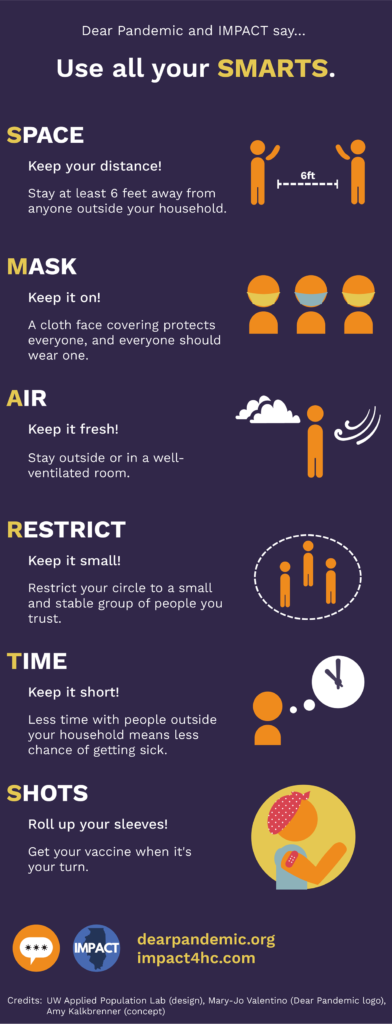A: Luckily, no. Virus mutations still don’t defy the laws of physics. But we need to be more vigilant about existing precautions, including getting BOTH doses of your vaccination.
TL;DR: The new variants are transmitted the same way as all the other variants of SARS-CoV-2, so you can reduce risk by using your #SMARTS:
↔️ Space: Keep your distance from other people.
😷 Masks: Keep your nose + mouth covered.
💨 Air: Keep it fresh.
🔄 Restrict: Keep your circle small.
🕐 Time: Keep your interactions brief.
💉 Shots: Get both doses of your vaccine!
❓Is the Delta variant more transmissible?
The Delta variant has become the dominant variant in the UK, replacing Alpha or B.1.1.7, and is on the rise in several other countries including the US. This quick replacement of Alpha as the dominant strain does suggest the variant has some transmission advantage. In the UK, Public Health England used contact tracing to estimate that Delta is 40-50% more transmissible than Alpha. More contacts of those infected with Delta were infected compared to those infected with Alpha.
Unfortunately a bit more transmission can quickly add up to big trouble, as we’re seeing with spiking cases even in the highly vaccinated UK.
A refresher on what we mean by transmissibility
❓HOW exactly do scientists think the virus is transmitted more easily?
This is still speculation, as scientists must infer how new mutations contribute to the success of the virus in infecting hosts and making copies of itself. They can get some clues from the lab, but how this operates in the real world is less clear. Hypotheses include that Delta has mutations on the spike protein that allow the virus to enter cells more easily, which might require fewer virus particles to take hold as an infection. There is some lab-based evidence that Delta can evade weak neutralizing antibodies, making re-infection or infection after partial vaccination more likely.
❓Can Delta evade immunity from vaccines?
Good news– So far real world data from the UK show only slightly reduced vaccine effectiveness (VE) against symptomatic disease with Delta, but still very high effectiveness against hospitalization. Reduced effectiveness after one dose was more noticeable than after two doses, prompting the UK to speed up the rollout of second doses to the older population. Two doses of the vaccine (either Astrazeneca or Pfizer) were 80% effective at preventing symptomatic disease and 94% effective at preventing hospitalization with the Delta variant.
Broken down by vaccine type, Pfizer VE against symptomatic disease after 2 doses was 88%, while it was 67% for Astrazeneca. For hospitalization the VEs were very close (and not distinguishable statistically)—96% for Pfizer and 92% for Astrazeneca.
❓How can you protect yourselves and families against Delta?
💥 The best way is to get vaccinated and encourage others to do so. And be sure to get that second dose.
For those still waiting for that second jab, with kids who are not eligible to be vaccinated, or who have less vaccine protection due to immunosuppression, you can minimize the chances of bringing Delta into your home with our old familiar strategies. This is especially true in public situations when you don’t know the vaccination status of those around you.
💥 Nothing about the mutations in Delta make it easier to get around masks, distancing, or good old soap and water.
Recall, the biggest risk for transmission in the presence of an infected person is SHARING AIR with someone, breathing the air that they exhale. The exhaled breath contains particles most concentrated close to the person breathing or speaking (picture your breath outside on a cold day).
❇️ SPACE & MASKS can minimize your breathing in the exhaled breath of others. The virus is carried by particles of mucus and saliva, so the distance these can travel is not changed by the new variant, nor is their ability to physically penetrate a mask.
❇️ AIR: While outside is best, remember that OUTSIDE IS NOT MAGIC if you are in close contact, especially without a mask. You can still breathe in that person’s breath.
Indoors, ventilation (meaning introducing outside air) is key. This outside air dilutes any virus in the air, pushes it outdoors, and stops it from accumulating indoors. HVAC systems can be set to bring in maximal outside air, but it’s also as easy as OPENING DOORS & WINDOWS (see more specific tips in FAQ and Slide links below).
❇️ RESTRICT: Fewer people in a room also limits the concentration of exhaled breath in the room.
❇️ TIME: If you are indoors with an infectious person emitting more virus particles from their breath, a 10-minute interaction may be as risky as a 20-minute interaction was before. Keep duration as short as possible.
The virus, no matter the variant, needs hosts to reproduce and survive, simple as that.
Do your part to deprive Delta of oxygen by getting vaccinated with 2 doses. When that is not possible, use the strategies above to minimize your risk of transmission.
💥 Remember the Swiss Cheese model—even lots of small measures with holes stacked together can add up to big protection.
Love,
Those Nerdy Girls
Further Reading:
“The Delta variant is serious. Here’s why it’s on the rise.”
Public Health England Technical Report on Delta Variant
Vaccine Effectiveness Estimates against Delta
FAQs on Protecting Yourself from COVID-19 Aerosol Transmission
Slide Presentation on Aerosol Transmission with suggestions on Filtration/Ventilation



